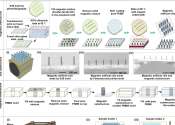Engineers create artificial cilia at the microscale
A small team of engineers at Eindhoven University of Technology in the Netherlands, working with a colleague from the Max Planck Institute for Intelligent Systems in Germany, has found a way to create tiny artificial cilia ...









